Exhibition labels
70: John Parkinson, Theatrum Botanicum
In 1640, eleven years after Earthly Paradise, Parkinson published his monumental Theatrum Botanicum (The Theatre of Plants). With over 3,800 plants discussed on 1,688 pages, it is the most complete English botanical treatise of its time, and remained a standard...
71: Richard Bradley
Richard Bradley, A General Treatise of Husbandry and Gardening (London, 1721) Sir Matthew Decker, a wealthy Dutch merchant and grandfather of the Fitzwilliam Museum’s founder was the first man to grow pineapples from scratch on English soil in the 1710s...
73: Tile depicting a couple in a garden
This comparatively inexpensive tile attests to English pineapple mania: its cheap transfer- printed image (a novel technique introduced at Liverpool in 1756) shows a well-to-do courting couple strolling on an elegant parterre past a large terracotta pot containing a flourishing...
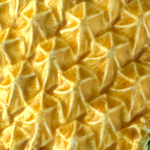
72: Teapot in the form of a pineapple
For some, the supreme artificiality of the home-grown British pineapple caused distrust and disapproval. In Tobias Smollett’s 1751 comic novel, Peregrine Pickle, Mrs Grizzle observed that she could never eat pineapples because they were “altogether unnatural productions, extorted by the...
74: Mould with pineapple motif, for flummery
Staffordshire, England, c.1760 Salt-glazed stoneware Private collection
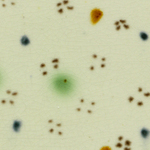
75: Six-sided oval dessert dish
Six-sided oval dessert dish with cusped and scalloped rim, supporting a replica pineapple flummery made by Ivan Day using no. 76 Yorkshire or Staffordshire, England, c.1780 – 90 Lead-glazed earthenware, painted underglaze Given by Sir Ivor and Lady Batchelor (C.5-1997)...

77: Wine glass
Wine glass with burnished gilt border and flower sprays, used for toasting, with replica toasting biscuits By the later 1700s, pineapples had become emblematic of welcome, hospitality, and friendship and were served at elegant dinners. Confectioners made pineapple-flavoured tarts, flummeries,...
Ginger and Sugar
Ginger and Sugar Ginger was an essential ingredient in medieval medicine and cooking. Tastes changed and by the late 1500s it was used less often in savoury dishes but remained popular in sweet ones. Humoral theory identified ginger as ‘hot’,...
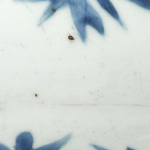
84: Baluster vase (‘ginger jar’)
Baluster vase (‘ginger jar’)with birds, peonies and bamboo, and cover Bulbous containers like this are traditionally called ‘ginger jars’. Made in China, their porcelain bodies and lids were painted with various decorations, including birds and flowers as seen here, under-glaze...
85: Ginger jar
Ginger jar and domed cover with putti amongst foliage Although the purpose of Chinese porcelain ‘ginger jars’ remains unclear, their bulbous shape became very fashionable in Europe. Imitations were made in silver during the seventeenth century, such as this one...
86: Sugar caster
Sugar caster with two unidentified coats-of-arms Étienne Bacquet, Paris, 1696 Pewter A.F. de Navarro Bequest (NAV.182-1933)
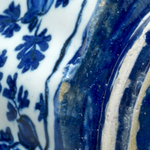
87: Sugar caster
Sugar caster with sprays, berries and flowers Metal Pot Factory, Delft, Netherlands, 1691–1724 Tin-glazed earthenware Dr J.W.L. Glaisher Bequest (C.2435 & A-1928)
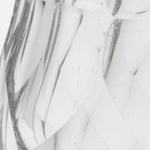
88: Sugar caster
Sugar caster with cap England, c.1750 Caster: lead glass Cap: silver Given by Miss E.H. Bolitho through The Friends of the Fitzwilliam Museum (C.153-1975)
89: Sugar bowl
Sugar caster, cover, and stand with flowers, foliage and birds Vincennes Porcelain Manufactory, France, c.1752 Soft-paste porcelain, enamels, gilt Louis C.G. Clarke Bequest, 1960 (C.13.2 & A & B-1961)
90: Sugar basket
Sugar basket with dog and birds, with liner, on 3 bracket feet Perfect for cooking, refined granulated sugar was also ideal for use at the table as a sweetener, either for sprinkling onto food or for dissolving into fashionable hot...
91: Double-sided gingerbread mould
Double-sided gingerbread mould with militiaman (front) and woman (back) Especially popular in northern Europe, gingerbread was made with both ginger and sugar. It was usually pressed in the shape of a figure or animal, using wooden moulds. These were often...
92: Double-sided gingerbread mould
Double-sided gingerbread mould with King William III (front) and Queen Mary II (back) Double-sided gingerbread moulds with a man carved into one side and a woman into the other are common. The English sugar banquet table at the start of...
93: Double-sided gingerbread mould
Gingerbread mould with the Royal coat-of-arms of George III Patriotic gilded gingerbreads in the form of the Royal Arms were also made from wooden moulds and sold at fairs. This is a late eighteenth-century example with the Royal arms of...
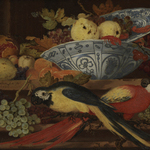
65: Still life with fruit and macaws
Still life with fruit and macaws Painted on copper for maximum luminosity, this brightly coloured image was designed to delight the senses. On the one hand, it celebrates abundance, luxury, and the exotic with succulent fruit, two New World macaws,...

67: Jug with pomegranates and hyacinths, and hinged cover
Together with the hyacinth, the pomegranate became a common decorative motif on later sixteenth-century polychrome tableware made in Ottoman Anatolia, as seen in this Iznik jug. It was likely made and exported to Elizabethan London shortly before 1592, when the...

68: ‘Clapmash’ bowl with pomegranates, grapes and foliage
Many seventeenth-century English ceramics are decorated with pomegranates, like this distinctively shaped ‘clapmash’ bowl, whose name derives from the Dutch 2019-12-04- ‘Klapmuts’, a sailor’s hat with a rounded crown and a broad flat brim. Its underside is dated ‘1639’ and...

81: Pineapple grown in Sir Matthew Decker's garden at Richmond, Surrey
Pineapple grown in Sir Matthew Decker’s garden at Richmond, Surrey As the first man in England to grow exotic pineapples from scratch, Matthew Decker, grandfather of the Fitzwilliam Museum’s founder, invited George I to sup on his delicious home-grown marvels....
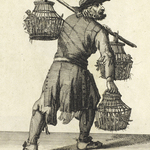
82: Enlarged projections of The Cryes of the City of London Drawne after the Life
These enlarged projections are from prints of food hawkers advertising their wares. They are intended to evoke the bustle, noise, and smell of selling a variety of foodstuffs on the streets of London. These images are part of a genre...
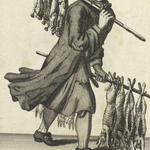
82: Enlarged projections of The Cryes of the City of London Drawne after the Life
Laroon’s images were called ‘The Cryes of the City of London Drawne after the Life’, suggesting he had pounded London’s streets and sketched what he saw. They are innovative in their use of brilliantly observed ‘eye-witness’ detail, designed to reinforce...
83: The market stall
The market stall The bare branches silhouetted against the lead-grey sky at top right indicate that it is Winter, as does the seasonal produce for sale. Baskets of dried fish, chestnuts, and medlars lie on the table while dried onions,...
94: Still life of a bowl of wild strawberries
Still life of a bowl of wild strawberries, standing cup, a bottle of rose water, a sugar loaf and a box of shot comfits This painting is a homage to sugar and sweetness in various forms. At front left is...
95: Pierre Pomet, A Complete History of Drugs (London, 1748)
This book by Louis XIV’s chief druggist provides written and visual evidence of the role of enslaved Africans in cane sugar production. After harvest, the cane was milled in ‘The Sugar Mill’, and its juice channelled into ‘The Sugar Works’...
96: Letter
Letter of 5 March 1797 to sugar plantation-owner, William Perrin, from his managers in Jamaica, detailing the harvest; with a list of enslaved people purchased to work on his plantations Many Europeans owned West Indian sugar plantations and exploited enslaved...
97: Sugar bowl
Sugar bowl promoting East India sugar ‘not made by slaves’ From the 1780s, the anti-slavery movement encouraged the public to make active choices when shopping, like refusing to purchase products made by ‘slave’ labour. This new ethical capitalism was promoted...





